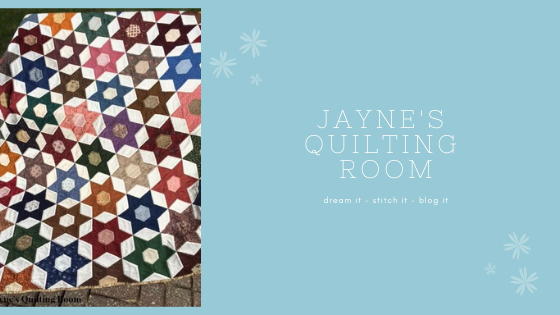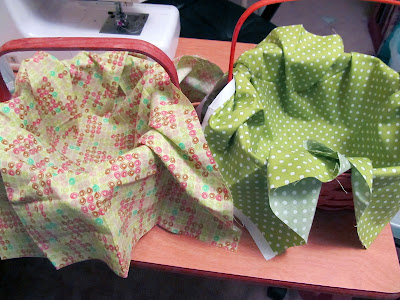I am undertaking a real challenge, so be prepared for an in-depth dissecting of the project. I am starting DD Erin's Hot Diamonds, which she picked out earlier this year. You can read about our fun Kaffe-stash dig by
clicking here.
I have been mentally working on this quilt ever since. After working with diamonds on the Lone Star quilt last year, I know to be respectful of the biases. I will be pressing every seam - not ironing, but carefully pressing - and taking extra-special effort to avoid stretching anything.
The two stars there by the title indicate its level of difficulty. I looked at all the other quilts in the book, and the only one with 3 stars is Broken Dishes, which I made in 2011. (
Click here to see it; go to quilt #4.) Initially, I would have argued that Hot Diamonds is trickier and therefore deserving of 3 stars. Now that I have done about half of it, I think 2 stars is a fair designation. Regardless, it is definitely
not for a beginner. I mean really, the entire quilt construction is explained in just 1 (one) paragraph. One paragraph with 2 sentences, no less. Here is said paragraph, verbatim.
"Using a 1/4in (6mm) seam allowance throughout, join the template OO diamond patches into the diagonal rows, filling in along the top edge of the quilt with template PP triangles, the sides of the quilt with template QQ triangles and the extreme corners with templates RR and reverse RR, as shown in the quilt assembly diagram. Refer to the quilt assembly diagram for fabric sequence, laying each row out in turn will help to keep the fabric sequence correct." (complete with poor sentence structure!)
Isn't that something? No directions for pressing, or stitching carefully, or matching points or anything!
One part that I spent so much time mentally wrangling is the cutting. The quilter is supposed to cut each individual piece
with templates and sew the entire quilt together, piece by piece. Here is the diagram for the side, top and corner triangles. Does this look like fun to you??
The main diamonds measure 5" wide. My thinking was that I would cut 5-inch strips for the main diamonds, sew several strips together and then cut them on the 60-degree line, eliminating having to cut each diamond individually. Basically, I would use quick-piecing methods. I did that with my Lone Star, so I figured it would work with this.
On second thought, though, I realized that this quilt has a major difference from the Lone Star. That quilt had several manageable units, whereas this quilt is one gigantic unit. I mean, it measures out at 108" x 93.5" - a huge quilt! How would I ever cut through all the strips, or how would I break the big quilt into smaller, more manageable units??
Maybe some of the quilting brainiacs out there could think this through, but I knew I wasn't up to it. I accept this reality.
So, I decided that I would, in fact, cut out all the diamonds, but I would not do it with templates! I was able to do that with my rotary cutter and ruler.
I marked the ruler with a line of sticky notes on the 60-degree line for the first cut.
Then I added more sticky notes on the 5-inch line to avoid cutting mistakes. All the diamonds are cut and lined up in sequence. Additionally, all the side, top, and corner triangles are cut and set aside. I decided that I would sew complete diagonal rows, like the directions suggest. I just gave in to it; I was not up to the task of figuring out anything better as far as chain-piecing goes.
This is my assembly line of diamonds. It would be so easy to get them mixed up if I didn't do this!
Here's what I had done as of Sunday evening. I love how it looks, and I am fascinated to see how the colors work. While the quilt is called Hot Diamonds, there is another version called Cool Diamonds, and I'm thinking Erin's will fall somewhere in between the two. It shall henceforth be called Erin's Diamonds.
This is what I have done at present. I've moved it off the wall to the bed. The weight of the growing quilt would surely have stretched those upper diamonds. To give you an idea of how big it will be, note that top row of blue - the one that looks like peacock feathers. The finished quilt will have 18 of those! Gi-normous! It will be massive - and heavy!
With this much done, I've learned the importance of placing each diamond just so to get a straight edge. There needs to be a quarter-inch dogear - the quarter-inch seam will start in that little valley - that's a way of knowing you have the two diamonds placed correctly.
When the row is pressed, there will be straight edges on each side. Joining the diagonal rows will be foolproof, theoretically. And for the most part, it has been working very well. I will occasionally get a block that doesn't cooperate, but I am NOT pulling or tugging to get it to fit! The biases will not beat me! I will live with a bit of an uneven edge because when the rows are joined together, I can compensate, and the offending edge will forever be hidden in the seam allowance.
That takes care of my individual piecing tips. For the construction of each long diagonal row, I go to my assembly line of diamonds arranged, as I said, in sequence. I stack every diamond for the row in order, and take the stack to the sewing machine.
To avoid all the stopping and starting of adding a piece at a time, I am using a speedier method. Keeping the stack of diamonds in order is essential, and it works like a dream. I sew the top triangle to the first diamond, and chain-piece the rest of the diamonds in the row. Diamond 2 to diamond 3; diamond 4 to diamond 5, and so on until I reach the side triangle. I cut the units apart, restack them in the correct sequence (to use Kaffe's terminology), and continue to chain piece these larger units until I get the entire row stitched. It definitely has helped me pick up the pace. I like that.
One other thing I am doing is making units of rows. If I continue to add row after row after row, it will just become too big and cumbersome to manage at the sewing machine. So I am going to divide it up into segments of 4 or 5 diagonal rows. Then I will only have the big massive quilt to deal with 2 or 3 times, instead of every time.
Even with all this thinking and figuring, I will just say, though, that I am loving putting this together. I can't believe I am making much faster progress on it than I expected.
Sorry for all talky-talk. This has been a
l - o - n - g post with a lot of detail - hope it made reasonably good sense.
Happy Quilting, Friends!






















































